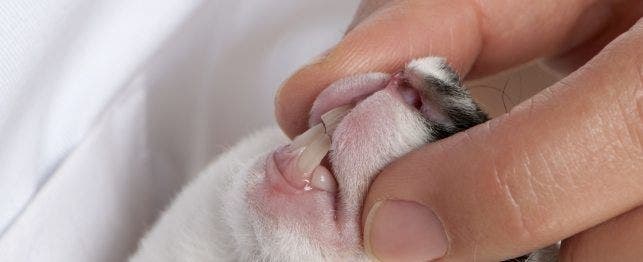
Keeping Your Rabbit’s Teeth Healthy
Picture a rabbit and what do you see?
Floppy ears and a fluffy tail. And a remarkable set of choppers. Rabbits have a total of 28 teeth: six incisor – or front – teeth and 22 premolars and molars, also called “cheek” teeth.
Dental troubles are among the most common health problems rabbits suffer. Some are preventable, some require occasional treatment, and some will plague your pet all his life. Here’s how to care for your rabbit’s teeth.
Rabbits’ Teeth Wear Down Quickly
Unlike human teeth, rabbits’ teeth have no enamel, which means they wear down quickly. They are open-rooted, meaning that the teeth continue to grow throughout the animal’s life. The nerves stop just beyond the gum line, which prevents pain as the tooth is being worn down.
In the wild, rabbits eat mainly grasses and low-growing shrubbery. The incisor teeth crop the plants; cheek teeth grind it up. Normally, the teeth don’t need much care. Constant cropping with the front teeth and chewing with the cheek teeth keep them well aligned and provide constant and even wear, preventing overgrowth. But sometimes, the teeth shift out of alignment, resulting in a condition called malocclusion.
- Incisor malocclusion usually occurs because the lower teeth protrude in front of the upper teeth. The lower teeth then grow very long outside the mouth, and the upper teeth curve backwards into the mouth, leaving the rabbit unable to crop his food.
- Molar malocclusion often leads to “points,” sharp edges on the teeth caused by uneven wear. These points can cut into the inner cheeks and tongue, which is painful for the animal and also leads to infection.
Warning Signs
- Drooling
- Teeth grinding
- Decreased food intake
- Dropping food
- Acting hungry but not eating
- Preference for soft foods
Treating Tooth Disease
Have your rabbit’s teeth checked each time he goes to the vet. If your rabbit is suffering from any form of malocclusion, your veterinarian will trim his teeth. Incisor teeth are usually trimmed without sedation; however sedation is required for proper trimming of the cheek teeth. Although trimming the teeth will not eliminate the problem, it will return the teeth to a normal length so your rabbit can eat properly, and will remove all the points that may be cutting into the gums.
Since malocclusion can’t be cured, your rabbit will require periodic trims. Frequency varies with the individual rabbit and the severity of the abnormalities; some rabbits need treatment once year; others may need it every two to three months.
After trimming the teeth, your veterinarian should clean wounds inside the mouth; most heal very quickly without treatment although antibiotics may be prescribed if your vet suspects infection.
Force-feeding may be necessary for the first few days after treatment. You can use vegetable baby food, pureed fresh vegetables or slurry made from ground up pellets and water.
If your rabbit continues to drool or seems to have trouble eating two to three days after the teeth are trimmed, have your veterinarian re-examine his mouth, to be sure there are no remaining points and to check to see that any cuts are healing.
In severe cases of malocclusion, your veterinarian may recommend surgical removal of the incisors.
Avoiding Problems
- Once every two weeks or so, examine your rabbit’s mouth by gently feeling around the bones of his jaw and face for bumps and swelling. Compare to the opposite side; if you feel a bump on both sides, it is most likely normal.
- Feed your rabbit good-quality pellets that are high in fiber.
- Watch your rabbit’s eating habits closely so the teeth can be taken care of as soon as they start to cause problems.
- Fresh hay should be available at all times to encourage grinding of the back teeth. Stem hay is better than commercially packaged leaf or “hay cubes.”